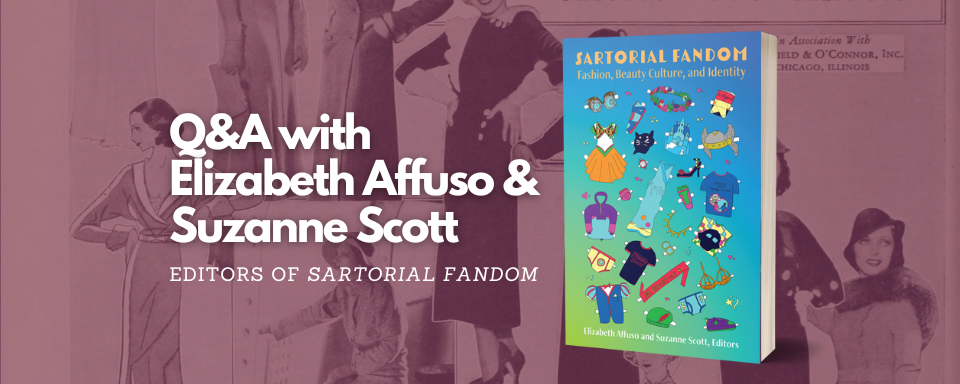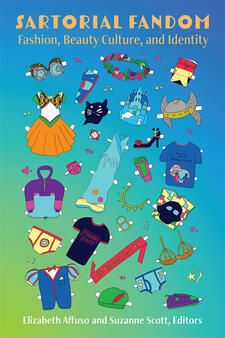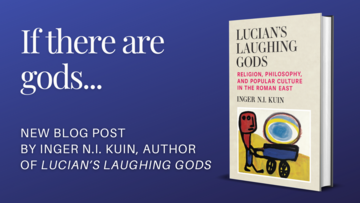Sartorial Fandom Q&A

This guest author post is a Elizabeth Affuso and Suzanne Scott, authors of Sartorial Fandom: Fashion, Beauty Culture, and Identity, from the University of Michigan Press. This book is available in hardcover, paper, and open access .
What inspired you to bring together an edited volume focused on sartorial fandom?
We initially started talking about sartorial fandom as a topic during the late-2000s when we noticed that fan fashion and beauty collaborations were exploding into the marketplace. In these early conversations, we were interested in how these collaborations reflected both the newfound chicness of geek culture and the position of fandom as a mainstream lifestyle category. Within Fan Studies and Media Studies, most of the work on fans and fashion has historically been centered on merchandise or cosplay and we wanted to explore the wider range of practices that sartorial fandom encompassed, while still representing these core areas. Our goal with the collection is to explore how fan fashion has evolved over time, and how it is performed in a wide array of fan communities and cultures, from early fan magazines to comic book conventions to theme parks to social media accounts. Centrally, the essays in this collection explore how identity (broadly defined) intersects with fan fashion and beauty culture.
What can fashion and fandom tell us about larger trends?
This collection is particularly focused on how fan fashion and beauty cultures reflect larger socio-cultural trends related to normative values, consumer culture, capitalism, and identity performance. Fashion and beauty cultures are significant areas for study due to their role as markers of identity and position as industries that prop up forms of hegemony along the lines of race, gender, age, ability, size, and so on. We are also interested in the ways that the fashion, beauty, and media industries respond to subcultural trends and consider fandom to be an important space where trends develop. The collection is also invested in how fandom is positioned as a consumer lifestyle brand within the economies of the fashion and beauty businesses and what that tells us about presentation of self.
What surprised you the most in your research?
During the process of editing, every single chapter offered a surprise, whether it was a fan object that has thus far been undertheorized or a novel theoretical lens. We designed this collection to showcase the wide array of approaches to exploring intersections between fandom and fashion, and while it’s wonderfully comprehensive we think a major surprise for the reader will be the realization of just how much more work there is still to be done on this topic. Each of these chapters offers a starting place for future work, and we are excited to see what emerges from it!
Chapters in Sartorial Fandom look at a variety of fandoms, including Star Wars, Harry Potter, and Disney. Do you personally have a fandom whose fashion is your favorite?
These franchises are often centered in discussions about sartorial fandom, precisely because their enduring mainstream appeal makes them valuable licenses, which in turn generates a wide array of fashion and beauty products (from fast fashion t-shirts to couture, to branded sneakers and make-up lines). What makes any of these franchises interesting is the deeply contextual nature of how sartorial fan objects move in the world and what they convey. So, taking Harry Potter, there’s a marked difference between how sartorial fan objects speak in the context of bachelorette parties for aging fan demographics, as mass-produced streetwear through a chain retailer, for fans in the immersive context of theme park environments, or as intimates or lingerie that may never be seen at all. Beyond these major franchises, one of our primary goals with this collection was also to turn attention to both fashion and fan objects that have been less discussed, and our contributors delivered with chapters on everything from anoraks to flower crowns to steampunk to diet and drop cultures.
What do you hope readers will take away from reading Sartorial Fandom?
We hope that readers come away with a more expansive view of the relationship between fashion and fandom across a range of modes of practice including retailers, branded products, and fan-made objects. Fan fashion and fan-oriented beauty products also offer a space to productively expand what we consider to be a “fan object,” as media texts, musicians, celebrities, and retail lines all involve distinct forms of sartorial fan expression. We hope the breadth of topics covered including early fan magazine fashion tie-ups, the history of Hot Topic, and KPop diets to name a few, is of use to scholars across a range of disciplines including Fan Studies, Media Studies, and Fashion Studies. As the first book collection on sartorial fandom, we hope that the book inspires other scholars to do future work in this area!







